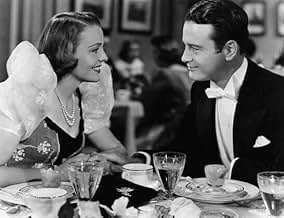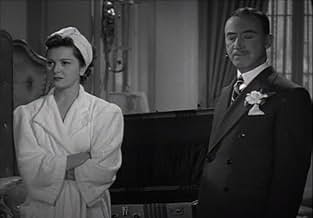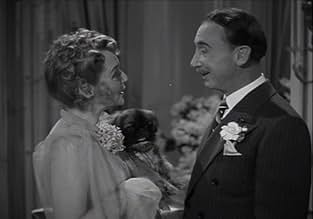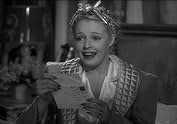Aggiungi una trama nella tua linguaA drunken college boy invites a taxi dancer to spend the weekend at his snobbish school.A drunken college boy invites a taxi dancer to spend the weekend at his snobbish school.A drunken college boy invites a taxi dancer to spend the weekend at his snobbish school.
- Regia
- Sceneggiatura
- Star
- Premi
- 1 vittoria in totale
Peter Lind Hayes
- Skel
- (as Peter Hayes)
Ernie Alexander
- Parking Attendant
- (non citato nei titoli originali)
Rod Bacon
- College Boy
- (non citato nei titoli originali)
Lee Bennett
- College Boy
- (non citato nei titoli originali)
Recensioni in evidenza
It may be lightweight fare, but the movie's still a revealing glimpse of the upper 1% of the 1930's. There's heartache aplenty when rich boy (Ayers) dates taxi dancer (Turner) from lower 99% and then stands her up in front of his snooty social circle. She's humiliated, to say the least, and we feel for her. Rich boy, Phil, has a lot to learn about life and people, and the remainder shows him trying to get things straight.
It's an MGM production so the glossy upper crust is spread on convincingly, from the high fashion clothes to the glittering ballrooms to the carefree attitudes. At the same time, the girls don't disappoint in the glamour department just as the title promises. We also get a cross-section of personality types from bitchy Daphne to misfit Betty to nice girl Carol. So it's lots of eye candy with some clumsy humor thrown in (the drunken Harvard man). But then, the movie turns dark near the end, and we see the downside of all the glitter (the stockbroker dad; an onrushing train). Notice, however, how biology ultimately triumphs over class.
The competition may be heavy but Turner shines as the working girl with stars in her eyes. But I especially like a rather obscure Jane Bryan (Carol) who projects an effortless inner radiance. Too bad that she left the business so soon. All in all, the film's a diverting peek into class mores of the time, a topic I expect still resonates with today's 99%.
It's an MGM production so the glossy upper crust is spread on convincingly, from the high fashion clothes to the glittering ballrooms to the carefree attitudes. At the same time, the girls don't disappoint in the glamour department just as the title promises. We also get a cross-section of personality types from bitchy Daphne to misfit Betty to nice girl Carol. So it's lots of eye candy with some clumsy humor thrown in (the drunken Harvard man). But then, the movie turns dark near the end, and we see the downside of all the glitter (the stockbroker dad; an onrushing train). Notice, however, how biology ultimately triumphs over class.
The competition may be heavy but Turner shines as the working girl with stars in her eyes. But I especially like a rather obscure Jane Bryan (Carol) who projects an effortless inner radiance. Too bad that she left the business so soon. All in all, the film's a diverting peek into class mores of the time, a topic I expect still resonates with today's 99%.
What a hidden little gem. Drunken rich college boy (Lew Ayres) invites working class girl (Lana Turner) to a big college dance. Once she arrives there, however, he has sobered up and forgotten all about her. Despite this and despite being treated badly by the snobby girls, Lana stays and shows them all up.
A delightful movie with a great cast full of beautiful young starlets. Lana Turner is gorgeous and her curvy figure is certainly different than most of the other girls. Her personality shines in this movie as well. She's really likable. Lovely Jane Bryan plays one of the nicer rich girls. Jane has a crush on a working class boy herself. Anita Louise is the viper of the bunch; the head mean girl. Ann Rutherford, adorable as ever, is the slow but cute one. Marsha Hunt plays a girl who is a little older than the others and is trying too hard to fit in. She's quite good to watch. Lew Ayres is charming, even when he's being a jerk. Richard Carlson plays the object of Jane Bryan's affections. Mostly lightweight but some darker parts as well. On the whole, lots of fun.
A delightful movie with a great cast full of beautiful young starlets. Lana Turner is gorgeous and her curvy figure is certainly different than most of the other girls. Her personality shines in this movie as well. She's really likable. Lovely Jane Bryan plays one of the nicer rich girls. Jane has a crush on a working class boy herself. Anita Louise is the viper of the bunch; the head mean girl. Ann Rutherford, adorable as ever, is the slow but cute one. Marsha Hunt plays a girl who is a little older than the others and is trying too hard to fit in. She's quite good to watch. Lew Ayres is charming, even when he's being a jerk. Richard Carlson plays the object of Jane Bryan's affections. Mostly lightweight but some darker parts as well. On the whole, lots of fun.
This film is a good example of MGM's early attempts to establish a screen persona for Lana Turner. Her role here as a dance hall hostess is similar to the rags-to-riches roles that Joan Crawford had successfully played early in her own career a decade earlier. However, Lana Turner just wasn't made to wear rags, and it wasn't until MGM put her into satins and jewels that audiences really responded.
This film is an entertaining mix of romantic comedy and social class commentary. The university town ("Kingsford") is obviously patterned after Princeton, NJ. (The eating clubs that host the prom in the film are still very much thriving institutions at Princeton.) There's a strong supporting cast and the condescending attitudes of some of the upper crust girls toward Turner is refreshingly realistic. (Amusingly, Turner apparently has red hair in this black-and-white film. Other characters refer to her as "Red").
This film is an entertaining mix of romantic comedy and social class commentary. The university town ("Kingsford") is obviously patterned after Princeton, NJ. (The eating clubs that host the prom in the film are still very much thriving institutions at Princeton.) There's a strong supporting cast and the condescending attitudes of some of the upper crust girls toward Turner is refreshingly realistic. (Amusingly, Turner apparently has red hair in this black-and-white film. Other characters refer to her as "Red").
A year after appearing together in "Love Finds Andy Hardy", Lana Turner and Ann Rutherford were paired up in two 1939 films: "These Glamour Girls" and "Dancing Co-Ed". Beyond having a college setting (with Turner playing an outsider), there was little similarity between the two films. Although much more ambitious, "Those Glamour Girls" is not in the same class as the more entertaining and lyrical "Dancing Co-Ed".
It is the standard depression era story contrasting the shallowness of the upper class and their moral depravity with the virtuous working class. Direction-less rich boy Philip S. 'Phil' Griswold III (Lew Ayres) invites dance club hostess Jane Thomas (Turner) to spend the weekend at his elite college where the various clubs are hosting a big dance.
Jane receives a mixed welcome from his crowd, the rich boys view her as an exotic novelty and the snooty girls as an inferior. As always happens in this standard story the rich people learn a lot of life lessons from the poor girl and are transformed into better, more responsible and mature citizens.
Turner is horribly miscast as the tough girl with a heart of gold. She has little chemistry with Ayres and looks grumpy and distressed most of the time. Her biggest assets were her smile and comic timing, making her much better physically as the wholesome girl-next-door than in this type of "too serious" role. Except for one very nice dance number at the midway point of the film there is nothing to even suggest that she would become a star.
This early twenties coming-of-age story tries to tackle more issues than it can reasonably handle, too many issues mean at best a superficial treatment for each. The results are disappointing as little of the interplay and character growth is convincing.
One exception is an excellent performance by Marsha Hunt as Betty Ainsbridge, a slightly older girl who has been left behind by her contemporaries and is trying to fit in with the younger crowd. Hunt (also a "Andy Hardy" veteran) does a great job of conveying the insecurities and desperation of a woman of that era confronting a future that holds fewer and fewer options for her. Unfortunately, her story is almost incidental to the main action of the film.
Then again, what do I know? I'm only a child.
It is the standard depression era story contrasting the shallowness of the upper class and their moral depravity with the virtuous working class. Direction-less rich boy Philip S. 'Phil' Griswold III (Lew Ayres) invites dance club hostess Jane Thomas (Turner) to spend the weekend at his elite college where the various clubs are hosting a big dance.
Jane receives a mixed welcome from his crowd, the rich boys view her as an exotic novelty and the snooty girls as an inferior. As always happens in this standard story the rich people learn a lot of life lessons from the poor girl and are transformed into better, more responsible and mature citizens.
Turner is horribly miscast as the tough girl with a heart of gold. She has little chemistry with Ayres and looks grumpy and distressed most of the time. Her biggest assets were her smile and comic timing, making her much better physically as the wholesome girl-next-door than in this type of "too serious" role. Except for one very nice dance number at the midway point of the film there is nothing to even suggest that she would become a star.
This early twenties coming-of-age story tries to tackle more issues than it can reasonably handle, too many issues mean at best a superficial treatment for each. The results are disappointing as little of the interplay and character growth is convincing.
One exception is an excellent performance by Marsha Hunt as Betty Ainsbridge, a slightly older girl who has been left behind by her contemporaries and is trying to fit in with the younger crowd. Hunt (also a "Andy Hardy" veteran) does a great job of conveying the insecurities and desperation of a woman of that era confronting a future that holds fewer and fewer options for her. Unfortunately, her story is almost incidental to the main action of the film.
Then again, what do I know? I'm only a child.
As a work of art, there is not much here - a poor cousin to "My Man Godfrey." As a "teaching moment," however, this film is a zinger. It tries to entertain but also to deliver a social message. It does so, so maladroitly that it ends up a perfect mirror of a mixed-up society, an almost-post-Depression society that was itself badly muddled and conflicted.
We are presented with a thoroughly obnoxious set of idle, moneyed, entitled, frivolous and uncaring young people. So much for a caricature of the upper classes. Ah, but then there is the heartwarming contrast with the poor but honest working-class heroine (Lana Turner - not a bad performance, but not quite convincing). So much for the clichéd social conflict. What lesson are we, the almost-post-Depression theater audience, intended to draw from this? Of course, the lesson is that we are all one. Even the obnoxious rich are not so bad. They will see the light. The rich boy and poor girl will marry. But do they? Not really. The rich kid loses his fortune. Not until then does he accept his love for the dime-a-dance girl. The once-rich-but-now-in-reduced-circumstances girl marries the poor student who must work his way through college. No one steps out of his or her economic sphere. The rest of the rich kids go off to continue their obnoxious, parasitic life-style. All is right with the world. No one is really bad. Smile. It is indeed extraordinary that the uber-rich kid's father is found to be a criminal. He has defrauded perhaps thousands of investors (probably including many poor investors) in his hedge-fund or Ponzi scheme; he's a veritable Bernie Madoff. Yet we are not expected to blame him or even to dislike him. "Thanks, dad, for having given me a good start in life," says his non-reproachful son. Capitalism is a tough business, not for the faint-hearted. It's all OK. The poor are virtuous. The rich are irritating but ultimately sympathetic. That is the lesson of "Glamour Girls." It's a message Hollywood was eager to deliver in 1939, and America was happy to receive. Maybe Hollywood was right. As the 19th century humorist Josh Billings, a friend of Mark Twain, put it, defining the American spirit: "Wealth won't make a man virtuous, but there ain't anybody who wants to be poor just for the purpose of being good."
As a social document, a relic of its time, the movie is revealing. As a film, a work of art, it is less than captivating - with one exception. That exception makes the whole thing worth seeing: the performance of Marsha Hunt. Her character, Martha, is the only one with depth. Her acting is the only one with profundity. Just watch her suicide scene. Watch her face as she drives toward her fatal moment. She registers nearly a dozen shifting emotions, all razor sharp and all without speaking a word, all in the space of a minute of screen time. First we see desperation as she speeds the car unheeding toward nowhere; then sadness; then surprise as she spots the train alongside; then a look of realization as the idea of what she can do strikes her; then happiness as it sinks in; then literal glee as she contemplates it; then fierce determination as she hits the accelerator; fear takes over as she reaches the crossing, fear as she nervously, fumblingly, lights a last cigarette; then glee again, a look of triumph as she stares at the sleeping drunken frat boy beside her - he will go down too. It is extraordinary acting. Marsha Hunt - I've seen her interviewed - said she didn't care to be a star. She wanted to be a character actress. She became one of the best. One year later she played the gawky, tone-deaf sister in "Pride and Prejudice." After that she played the heroic but devastated victim of Nazi oppression in "None Shall Return." She portrayed a nasty, conniving home-wrecker in "Smash-Up," then a gentle, conflicted lover in "Raw Deal." If nothing else, "Glamour Girls" gives us one sublime actress at her peak.
We are presented with a thoroughly obnoxious set of idle, moneyed, entitled, frivolous and uncaring young people. So much for a caricature of the upper classes. Ah, but then there is the heartwarming contrast with the poor but honest working-class heroine (Lana Turner - not a bad performance, but not quite convincing). So much for the clichéd social conflict. What lesson are we, the almost-post-Depression theater audience, intended to draw from this? Of course, the lesson is that we are all one. Even the obnoxious rich are not so bad. They will see the light. The rich boy and poor girl will marry. But do they? Not really. The rich kid loses his fortune. Not until then does he accept his love for the dime-a-dance girl. The once-rich-but-now-in-reduced-circumstances girl marries the poor student who must work his way through college. No one steps out of his or her economic sphere. The rest of the rich kids go off to continue their obnoxious, parasitic life-style. All is right with the world. No one is really bad. Smile. It is indeed extraordinary that the uber-rich kid's father is found to be a criminal. He has defrauded perhaps thousands of investors (probably including many poor investors) in his hedge-fund or Ponzi scheme; he's a veritable Bernie Madoff. Yet we are not expected to blame him or even to dislike him. "Thanks, dad, for having given me a good start in life," says his non-reproachful son. Capitalism is a tough business, not for the faint-hearted. It's all OK. The poor are virtuous. The rich are irritating but ultimately sympathetic. That is the lesson of "Glamour Girls." It's a message Hollywood was eager to deliver in 1939, and America was happy to receive. Maybe Hollywood was right. As the 19th century humorist Josh Billings, a friend of Mark Twain, put it, defining the American spirit: "Wealth won't make a man virtuous, but there ain't anybody who wants to be poor just for the purpose of being good."
As a social document, a relic of its time, the movie is revealing. As a film, a work of art, it is less than captivating - with one exception. That exception makes the whole thing worth seeing: the performance of Marsha Hunt. Her character, Martha, is the only one with depth. Her acting is the only one with profundity. Just watch her suicide scene. Watch her face as she drives toward her fatal moment. She registers nearly a dozen shifting emotions, all razor sharp and all without speaking a word, all in the space of a minute of screen time. First we see desperation as she speeds the car unheeding toward nowhere; then sadness; then surprise as she spots the train alongside; then a look of realization as the idea of what she can do strikes her; then happiness as it sinks in; then literal glee as she contemplates it; then fierce determination as she hits the accelerator; fear takes over as she reaches the crossing, fear as she nervously, fumblingly, lights a last cigarette; then glee again, a look of triumph as she stares at the sleeping drunken frat boy beside her - he will go down too. It is extraordinary acting. Marsha Hunt - I've seen her interviewed - said she didn't care to be a star. She wanted to be a character actress. She became one of the best. One year later she played the gawky, tone-deaf sister in "Pride and Prejudice." After that she played the heroic but devastated victim of Nazi oppression in "None Shall Return." She portrayed a nasty, conniving home-wrecker in "Smash-Up," then a gentle, conflicted lover in "Raw Deal." If nothing else, "Glamour Girls" gives us one sublime actress at her peak.
Lo sapevi?
- QuizFirst film where Lana Turner receives top billing.
- Citazioni
Jane Thomas: Listen, you wisecracking, bad-mouthing glamour girl. I've had all your kind of friend that I can use. Why, I wouldn't breathe the same air with you and your pedigree polo shirts for another five minutes.
- ConnessioniFeatured in Discovering Film: Lana Turner (2015)
- Colonne sonoreLoveliness
(1939)
Music by Edward Ward
Lyrics by Bob Wright and Chet Forrest
Played during the opening credits
Sung by Dale Fellows (uncredited) at the social
Hummed by Lana Turner (uncredited)
Played as background music often
I più visti
Accedi per valutare e creare un elenco di titoli salvati per ottenere consigli personalizzati
Dettagli
Botteghino
- Budget
- 403.000 USD (previsto)
- Tempo di esecuzione1 ora 19 minuti
- Colore
- Proporzioni
- 1.37 : 1
Contribuisci a questa pagina
Suggerisci una modifica o aggiungi i contenuti mancanti

Divario superiore
By what name was These Glamour Girls (1939) officially released in Canada in English?
Rispondi



































